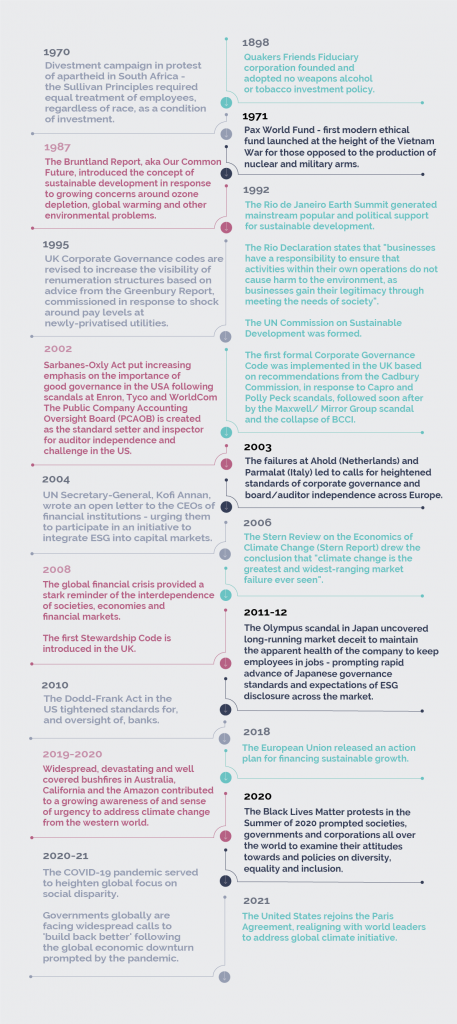5 minute read
The concept of sustainability has been around for a long time. It has been a focus for scholars and thinkers in ever greater numbers, especially since the industrial revolution in the 18th century. Industrialisation showed us the possibility of an unsustainable world by opening our eyes to the concept that natural resources are finite, as well as highlighting ever growing social and wealth inequalities.
 Watch: The history of sustainability from the Arizona State University Sustainability Science Education YouTube channel
Watch: The history of sustainability from the Arizona State University Sustainability Science Education YouTube channel
Key points:
- Sustainability is an offshoot of environmentalism, but it goes much further – integrating social justice, economic growth and environmental thought to influence change.
- The Triple Bottom Line model looks at the relationships between society, the economy and the natural world.
- Sustainability aims to find solutions to the complex problem that the world faces today.
Triple bottom line
Within accounting, the triple bottom line concept expands the traditional accounting framework from focusing purely on profit to incorporating the social and environmental impacts of a company.
The three aspects are often referred to as the ‘three Ps’. These elements neatly reflect environmental, social and governance factors as they relate to business management and investment decisions.
1. People (i.e. social)
2. Planet (i.e. environmental)
3. Profit (i.e. governance)
Stakeholder theory and stakeholder capitalism
Closely related to the triple bottom line model is the stakeholder theory and the concept of stakeholder capitalism.
 Watch: R. Edward Freeman – What is stakeholder theory?
Watch: R. Edward Freeman – What is stakeholder theory?
Key points:
- Stakeholder theory is an idea about how business really works.
- It says that to be successful, a business must create value for customers, suppliers, employees, communities and financiers.
- No one of those stakeholders can be examined in isolation – their interest must go together.
- Stakeholder theory says if you just focus on financiers, you miss what makes capitalism tick, which is that shareholders, financiers, employees, suppliers, communities can, together, create something that no one of them can create alone.
 Watch: MSCI – 2020 ESG Trends – Stakeholder capitalism
Watch: MSCI – 2020 ESG Trends – Stakeholder capitalism
Key Points:
- In 2019, global business leaders put their weight behind the idea that companies exist to serve groups beyond their shareholders.
- Companies are accountable to customers, employees, suppliers and communities.
- Shareholders and consumers still have the greatest ability to influence a company.
The United Nations Sustainable Development Goals
In 2015 the United Nations (UN) came up with 17 goals for global sustainable development, to replace the millennium goals. The UN describes the goals as a ‘blueprint to achieve a better and more sustainable future for all’. The call to action is widespread, calling on individuals, businesses and governments to take action. As we shall discuss in Module 2, they have provided a useful framework for investors who want to evidence positive change.

 Recommended Read: Explore the UN SDG website for more detail and information on the 17 goals.
Recommended Read: Explore the UN SDG website for more detail and information on the 17 goals.
 Recommended Watch: Nations United: Urgent Solutions for Urgent Times, Presented by Thandie Newton
Recommended Watch: Nations United: Urgent Solutions for Urgent Times, Presented by Thandie Newton
Nations United is a special, first of its kind film. The United Nations created this on its 75th Anniversary to mark five years since the adoption of the sustainable development goals (SDGs).
Evolution of responsible investing
Responsible investing, or ethical investing in its earliest forms, has been around for most of human history. The opening books of the New Testament, which date to circa 1500 BC, prescribe rules for all aspects of living, including financial and economic practices.
Over the last century, the modern concept of responsible investing has evolved from its earliest forms amongst the peaceful Quakers who opposed slavery in the Americas, to the sophisticated and multi-faceted markets that we know today.
The graphic below charts the key events and milestones over the last century, including the development of responsible investing.


